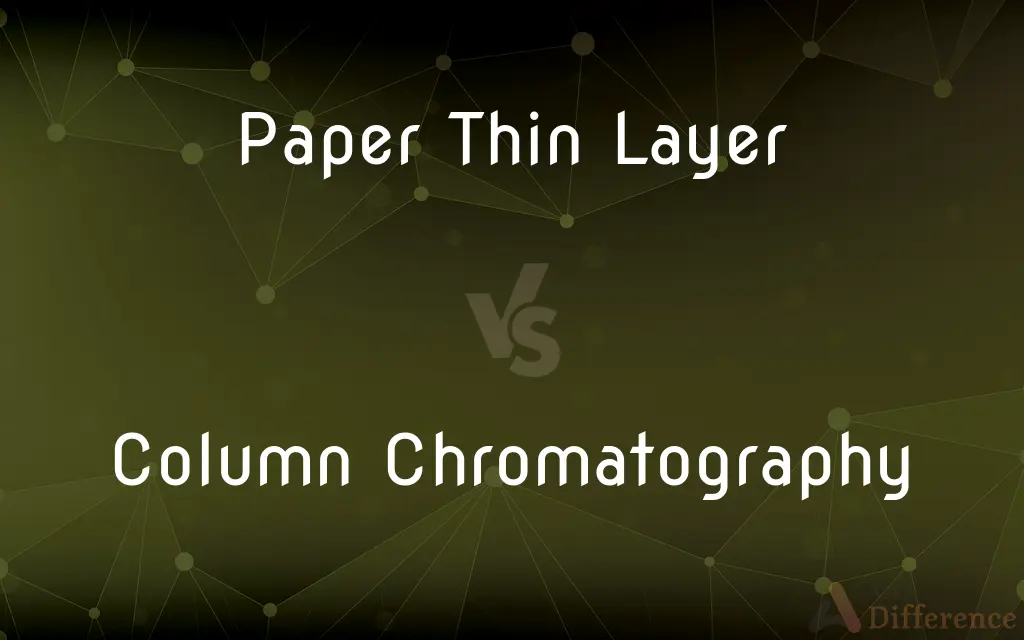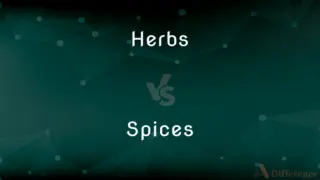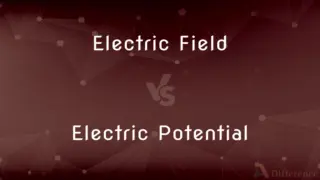Paper Thin Layer vs. Column Chromatography — What's the Difference?
By Tayyaba Rehman — Published on November 5, 2023
Paper Thin Layer Chromatography (TLC) uses a stationary phase on a flat plate for separating mixtures, while Column Chromatography employs a column packed with a stationary phase for separation. Both leverage different physical forms for separation.

Difference Between Paper Thin Layer and Column Chromatography
Table of Contents
ADVERTISEMENT
Key Differences
Paper Thin Layer Chromatography (TLC) epitomizes a form of chromatography wherein separation processes occur on a flat, planar surface, fundamentally enabling a visual and straightforward method of analyzing mixtures. Contrarily, Column Chromatography is characterized by its utilization of a column, typically a tube filled with a stationary phase, through which the mobile phase is percolated, providing an effective albeit somewhat less visually immediate separation technique.
Notably, Paper Thin Layer Chromatography establishes itself as particularly accessible and is frequently harnessed in quick, qualitative analyses, presenting results that are immediate and tangible on the coated paper or plate. However, Column Chromatography often finds application in larger scale separations and purifications, delivering a capacity for handling greater volumes and, oftentimes, enabling a more comprehensive separation of complex mixtures.
The substrate in Paper Thin Layer Chromatography is often coated with silica gel, alumina, or other adsorbents that facilitate the separation of components based on their relative adhesiveness to the stationary phase and solubility in the mobile phase. Differently, Column Chromatography might utilize a range of stationary phases, including beads of polymers, and allow different types of interactions, such as size exclusion or ion exchange, to effectuate separation, thereby offering diverse utility in numerous analytical scenarios.
Paper Thin Layer Chromatography commonly necessitates a shorter duration for a separation to be completed, oftentimes delivering results within a matter of minutes or hours. Contrasted with Column Chromatography, which might span a longer timeframe and require meticulous attention to the elution of compounds, the speed and complexity of the two techniques might be directed toward different analytical ends.
Both Paper Thin Layer and Column Chromatography, despite their distinct methodologies and application areas, underscore the vital principle of chromatography: the differential migration of components in a mixture, guided by their distinct affinities for stationary and mobile phases. Thus, while the planar, visual separations of Paper Thin Layer might cater to rapid, qualitative analyses, the voluminous and varied separations of Column Chromatography might find preference in preparative and comprehensive applications.
ADVERTISEMENT
Comparison Chart
Form
Flat, planar surface
Column/tube
Typical Use
Quick, qualitative analyses
Larger scale separations/purifications
Stationary Phase
Coated with silica or alumina
Can use various materials
Duration
Often rapid, minutes to hours
Can be prolonged, hours to days
Scale of Analysis
Typically small-scale
Can handle larger volumes
Compare with Definitions
Paper Thin Layer
Stationary phase is a solid, adherent layer.
The Paper Thin Layer is crucial for adhering and separating mixture components.
Column Chromatography
Often utilized for preparative purposes.
Column Chromatography was used to prepare pure samples for further study.
Paper Thin Layer
Enables visual observation of separated components.
Paper Thin Layer Chromatography revealed colored bands of separated compounds.
Column Chromatography
Can handle larger volume separations.
Researchers used Column Chromatography for purifying a sizable sample.
Paper Thin Layer
A technique using a flat phase for separation.
The chemist used Paper Thin Layer Chromatography for a rapid analysis.
Column Chromatography
Potentially enables various interaction types.
The scientist utilized ion exchange Column Chromatography in his research.
Paper Thin Layer
Often utilizes silica or alumina coatings.
Silica is common in Paper Thin Layer Chromatography for separating compounds.
Column Chromatography
Typically involves longer duration analyses.
Column Chromatography required several hours to separate the compounds.
Paper Thin Layer
Widely employed for swift, qualitative analyses.
Paper Thin Layer Chromatography provided quick results in the laboratory.
Column Chromatography
Employs a column filled with a stationary phase.
Column Chromatography efficiently separated the complex mixture.
Common Curiosities
Can Column Chromatography handle complex mixtures?
Yes, Column Chromatography can often separate complex mixtures effectively.
How does Column Chromatography manage separations?
Column Chromatography separates mixtures by percolating them through a column filled with a stationary phase.
What’s a key visual difference between Paper Thin Layer and Column Chromatography?
Paper Thin Layer Chromatography allows direct visual observation of separations, unlike Column Chromatography.
Is Column Chromatography usually rapid?
Column Chromatography can be lengthy, especially compared to Paper Thin Layer Chromatography.
What typically coats the plane in Paper Thin Layer Chromatography?
Often, silica or alumina coats the plane in Paper Thin Layer Chromatography.
Can different interaction types be utilized in Column Chromatography?
Yes, Column Chromatography can use various interactions like ion exchange or size exclusion.
What is the basic form of Paper Thin Layer Chromatography?
Paper Thin Layer Chromatography employs a flat, planar surface for analyses.
Are both methods employed for qualitative analysis?
While both can be, Paper Thin Layer Chromatography is more commonly used for quick, qualitative analyses.
What’s a drawback of Paper Thin Layer Chromatography?
Paper Thin Layer Chromatography may not be as suitable for preparative or large-volume work as Column Chromatography.
Is Paper Thin Layer Chromatography suitable for large-scale separations?
Typically, Paper Thin Layer Chromatography is utilized for smaller, qualitative analyses.
Is Paper Thin Layer Chromatography suitable for complex mixtures?
It can separate components, but may not be as effective as Column Chromatography for very complex mixtures.
Can both techniques separate multiple components in a mixture?
Yes, both Paper Thin Layer and Column Chromatography can separate multiple components.
How does the scale of operation compare between the two methods?
Paper Thin Layer Chromatography is generally small-scale, while Column Chromatography can handle larger volumes.
Are both methods used in analytical chemistry?
Yes, both Paper Thin Layer and Column Chromatography are vital in analytical chemistry.
Can Column Chromatography separate components to high purity?
Yes, Column Chromatography can be highly effective in purifying components to high degrees.
Share Your Discovery

Previous Comparison
Herbs vs. Spices
Next Comparison
Electric Field vs. Electric PotentialAuthor Spotlight
Written by
Tayyaba RehmanTayyaba Rehman is a distinguished writer, currently serving as a primary contributor to askdifference.com. As a researcher in semantics and etymology, Tayyaba's passion for the complexity of languages and their distinctions has found a perfect home on the platform. Tayyaba delves into the intricacies of language, distinguishing between commonly confused words and phrases, thereby providing clarity for readers worldwide.
















































